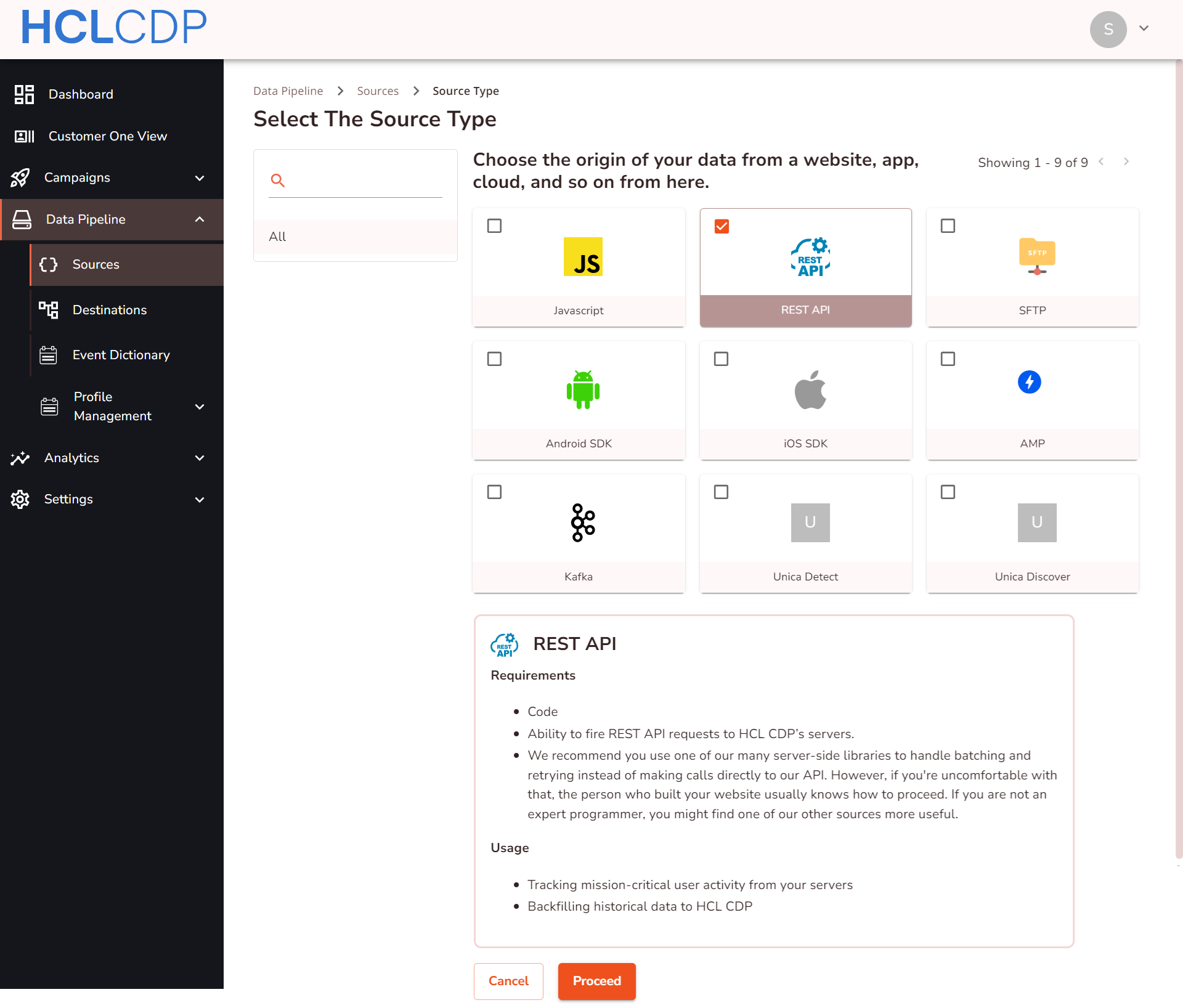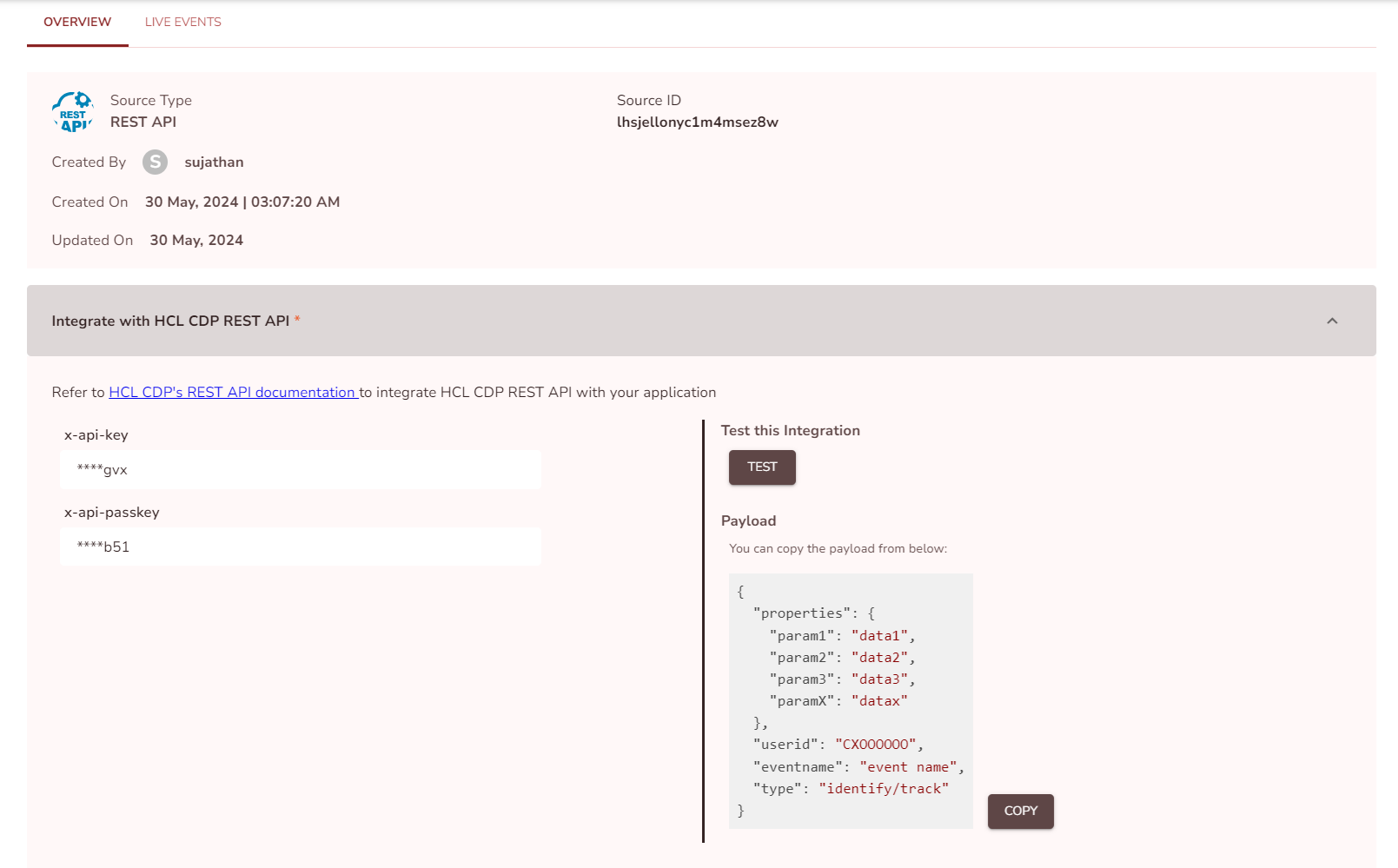REST API
This document provides detailed technical guidance on integrating the HCL CDP REST API to send website or app data to your configured destinations. Use this document alongside an Event Tracking Plan provided by your HCL CDP Customer Success contact to ensure proper and complete implementation.
The HCL CDP REST API serves as a data collection source, enabling you to track customer events across any platform (web, Android, or iOS). Each API request processes your data and routes it to the destinations configured in your HCL CDP Dashboard.
Configure REST API as Source
- Navigate to Data Pipeline > Sources, and click +Create New Source.
- Select the source type as REST API, and click Proceed.

- In the Source name field, add a unique name to the source, and click Create.
- Every request must include two headers,
x-api-keyandx-api-passkey. These keys are displayed in a pop-up when creating the source.Note: Copy the keys immediately as they will not be shown again.
Testing the Integration
To test the integration, configure the REST API credentials and click TEST to validate the integration. A success message will confirm the correct configuration.
Payload Testing: A sample payload format for events is provided during the setup process. You can copy the payload and use it while sending API requests.

Making a Request
Supported event types
The REST API source only supports identify and
track event types.
Supported HTTP methods
The REST API supports the following HTTP methods:
POST: To create or update profiles.DELETE: To remove objects or delete profiles entirely.
Endpoint
Base Endpoint: https://crux.dev.hxcb.now.hclsoftware.cloud/v3/data
POST Request Specifications
Request Structure
A sample payload for ingesting 1 record is given below.
{
"properties": {
"param1": "data1",
"param2": "data2",
"param3": "data3",
"paramX": "datax"
},
"userid": "CXOOOOOO",
"eventname": "event name",
"type": "identify/track"
}
The parameter definition for accepted fields is provided below:
| Parameter | Type | Description |
| properties | Object | Event-specific attributes (key-value). |
userid required |
String | Mandatory User ID or Anonymous ID. |
| eventname | String | Name of the event being tracked. |
| type | String | Event type: "identify" or "track". |
PII Data handling
For personally identifiable information (PII), include email
(lowercase) and mobile (E.164 format) within the properties object.
Example Request
curl --location 'https://crux.dev.hxcb.now.hclsoftware.cloud/v3/data' \ --header 'Content-Type: application/json' \ --header 'x-api-key: xxxx' \ --header 'x-api-passkey: xxxx' \ --data '[ { "properties": { "CUSTOMER_ID": "ID000001", "CITY": "New York", "STATE": "NY", "COUNTRY": "USA" }, "eventname": "Account Created", "type": "track" } ]'
[
{
"message": "Data Processed successfully",
"id": "2510c39011c5be704182423e3a695e91"
},
{
"message": "Invalid input request. Incorrect userid.",
"id": ""
}
]| Parameter | Type | Description |
| message | Object | Status of the event processing. |
| id | String | User ID or object identifier. |
DELETE Request Specifications
Request Structure
A sample payload to delete 3 records is given below:
[
{
"properties": {
"id": "someid"
},
"object": "Segment"
},
{
"properties": {
"id": "anotherid"
},
"object": "__profile"
}
]| Parameter | Type | Description |
| properties | Object | Key-value pair used to identify the target object. |
| id | String | Object type (e.g., "Segment", "Lead", "__profile"). |
- Use
__profileto delete the entire user profile. - The id parameter must uniquely identify the object.
curl --location --request DELETE 'https://crux.dev.hxcb.now.hclsoftware.cloud/v3/data' \ --header 'Content-Type: application/json' \ --header 'x-api-key: xxxx' \ --header 'x-api-passkey: xxxx' \ --data '[ { "properties": { "id": "23423" }, "object": "Segment" } ]'
[
{
"message": "Segment object deleted successfully",
"id": "2510c39011c5be704182423e3a695e91"
},
{
"message": "Profile not found.",
"id": ""
}
]Response Code
| Status Code | Description |
| 200 Success | Data processed successfully. |
| 400 Bad Request | Payload format is incorrect. |
| 401 Unauthorized | Missing or invalid x-api-key or
x-api-passkey. |
| 500 Server Error | Issue occurred while processing the request. |
FAQs
Q1. Which event types are supported with the HCL CDP REST API?
The HCL CDP REST API
supports identify and track event types.
Q2. Why am I receiving a 400 Bad Request error?
- Verify your payload matches the provided schema.
- Ensure
useridand other mandatory fields are correctly populated. - Validate your JSON payload using tools like Postman.
Q3. How do I obtain x-api-key and
x-api-pass-key?
The API keys are displayed when you create a REST API source. Ensure you save them securely as they will not be displayed again.